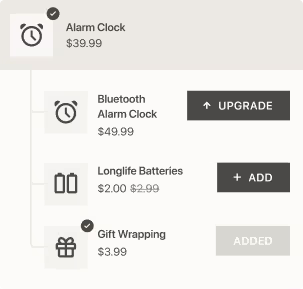Imagine a situation where a customer bought a monthly supply of special dog food (sensitive stomach type) from an online store. Now compare two scenarios.
In the first one, a customer receives an email shortly before that monthly supply runs out and follows the link to the same dog food with 10% off. When they add it to the cart, the store suggests additional treats, also suitable for sensitive stomach dogs. A satisfied customer completes a purchase thinking that they will probably return to the same store.
In the second scenario, a customer doesn’t receive any notification and goes to the store when they realize they’ve run out of dog food. They spend some time on a website searching for the right type of food. When searching, they see irrelevant pop-ups promoting treats and products that are not suitable for their dog. As a result, a customer might abandon the cart or complete a purchase but think about finding another pet store in the future.
The gap between these store experiences is personalization. It’s not just a buzzword of digital marketing but an actual need of online shoppers. Consumers seek personalization and will stick with the store that provides it to them.
A survey by Researchscape shows that an overwhelming majority of marketers (88%) agree that customers expect personalized experiences. Even if your store has an interactive design, loads fast, and features great products, you’ll be losing customers without personalized messaging.
And the way to achieve personalization is through customer segmentation.
What is customer segmentation?
Customer segmentation entails creating separate groups of customers based on any chosen criteria, be it demographics or behavior on a store. These groups are further used to tailor more personalized messages in emails, in-store pop-ups, and so on.
This technique is crucial for e-commerce success for multiple reasons. Let’s see why customer segmentation is important.
Why customer segmentation can help your business
Marketers surveyed by Researchscape identified improvements in engagement, customer experience, and conversion rates as the most significant benefits of personalization:

By dividing your customers into groups and approaching those groups differently, you can achieve the following:
- Increasing conversion rates. A study by Appboy showed that marketing campaigns targeted at particular customer groups have 200% higher conversions than campaigns that use the same message for everyone. Numerous studies and surveys support the fact that customer segmentation in marketing brings significantly more conversions.
- Reaching a higher CLV. Customer Lifetime Value (CLV) is the average monetary value of your customers calculated by multiplying the average sale by the number of transactions by the retention period.
If a customer buys dog food from the same store every two months spending $30 on average and remains loyal for 5 years, then the CLV equals $900 (30 * 6 * 5). But if you attract a customer with personalized recommendations—say additional dog treats worth an extra $10 for each order—and will keep them aware of your brand—with personalized offers and reminders to stock up each month, you might reach the CLV of $2,400 (40 * 12 * 5). Plus, with all these efforts, chances are a customer will stick to your store longer, which will increase the CLV even further.
- Understanding the market and your target audience better. With segmentation, you’ll have some insights on a silver platter: you’ll see how many customers are abandoning their cart, how many tend to make expensive orders, how many show loyalty to your store, how many are on the fence choosing between alternatives, etc.
- Improving customer satisfaction and loyalty. Personalized offers achieved through segmentation speak to very specific needs and sometimes predict them. Consumers spend less time browsing and feel cared about, which translates into higher engagement and loyalty.
- Identifying the store’s problems. Finding issues to fix is another reason why companies use segmentation. When you have a breakdown of users by their online behavior, you can clearly see if there are obvious conversion blockers.
For instance, you find out that indecisive shoppers represent the biggest segment—they spend a lot of time on your store browsing through categories but don’t add anything to the cart. It might signal that you need to rethink your website’s structure and navigation, implement a chat to help visitors make a decision, etc.
Segmentation methodology: how to distinguish customer groups
There are different approaches to customer segmentation in e-commerce which can be combined in any way you find helpful.
The most traditional methods of segmentation are rooted in demographic and geographic parameters. They are fading out, giving way to behavioral aspects, but remain valid in some contexts. Let’s explore how segmentation works based on different criteria.
Demographic method of segmenting customers
The demographic segmentation method is based on consumers’ age, gender, family status, occupation, religion, and other parameters. It makes sense to take any of those into account only if you have products only marketable to a particular demographic group: for example, merchandise related to teen icons or age-specific skincare.
How to collect demographic data?
Shopify doesn’t automatically gather these types of data on customers. You can check the Demographics report in Google Analytics but it will only show aggregated data that isn’t connected to each individual customer and order IDs. To be able to do the latter, you can add specific fields to the registration form—for example, with the help of an app like Customer Fields. But if you allow shoppers to checkout without creating an account, you won’t have such data on everyone.
How to leverage demographic data?
Besides promoting products that are relevant to a particular demographic group, you can use universally appropriate information—date of birth. Craft a special offer and send it shortly before the customer’s birthday. It’s a nice way to congratulate a person and show that you care while promoting your products or services.

Marketing segmentation methods based on location
The geographic approach to customer segmentation is based on user location, language, currency, and other country- or region-specific factors. You’ll only need such segments if your website targets multiple locations.
How to collect geographic data?
Regardless of whether users create accounts on your store or not, you’ll have their primary address filled in for order delivery. Based on that information alone, you can create new customer segments and personalize your communication.
If you have a multi-language store, you’ll also see which language version each customer used. Shopify customer segmentation options include a language-based filter. Knowing that, you’ll be able to communicate with everyone in their own language.
How to leverage geographic data?
Here’s what you can consider while tailoring your campaigns to different location groups:
- Language of communication (to speak the customer’s language and show them links to a relevant language version of the site).
- Customers’ time zone (to choose the time to send promotional emails, etc.).
- Climate and seasonality (to understand when to promote seasonal products like winter apparel or winter gear).
- National holidays (to promote holiday gifts only when it’s relevant).

Psychographic segmentation methods
Another approach to customer segmentation in e-commerce relies on values and beliefs. Research shows that 63% of consumers prefer brands that share their values. Your job is to find out how to communicate those values and use psychographic segments in promotional campaigns.
How to collect psychographic data?
You’ll need to go through psychographic customer segmentation metrics manually. What values you can use for segmentation depends on the assortment of your store.
For instance, a store that sells hair care products has sections of organic and vegan items. Customers that buy exclusively from these sections might be offended if you recommend something non-organic and non-vegan to them. And on the contrary, they will be happy to receive news and special offers applicable to their favorite brands and products. So, it makes sense to create a segment of organic and vegan shoppers.
Another thing to consider with psychographic groups is hobbies. Distinguish different interests of customers based on their order history. As an example of customer segmentation reliant on interests, a sports equipment store might have segments of tennis lovers, home fitness enthusiasts, yoga practitioners, etc.
How to leverage psychographic data?
With different value- and interest-based segments at your disposal, you can create effective product bundles, relevant upsells, and other promotional offers. When marketers segment based on psychographics, the results might be a stronger connection with customers and, in turn, higher loyalty.
Behavioral customer segmentation strategy
Finally, the behavioral method is proven to be the most precise and effective. In a Databox survey, 38.7% of respondents claimed behavioral customer segmentation to be the most robust:

For behavioral segmentation, you’ll be analyzing previous customer interactions with your store and their order history.
How to collect behavioral data?
The most important factors of user interactions with your store are already included in any Shopify plan.
In the Customers section of your admin account, you have access to ready-to-use segmentation templates:

The templates include a predefined set of filters that you can use as it is or modify it to fit your criteria.

If you want to use filters instead, choose the filtering option and specify your criteria. For example, you might create high-value Shopify customer segments who made more than 5 orders and spent more than $1,000:

There’s also an automated way of collecting customer data related to order history—Shopify segmentation apps. The Loyal app will create 6 segments based on the RFM method (free of charge for any Shopify store).
The RFM analysis is one of the types of behavioral segmentation that focuses on recency, frequency, and monetary value of customer purchases.
With the help of Loyal, you’ll get segments of customers most worthy of communicating with: those who might become your loyal audience, those who are at risk of churn, etc. The app’s algorithms follow the best practices of customer segmentation and will also give you marketing recommendations on how to build relationships with each identified segment.

How to use customer segmentation based on behavioral data?
Let’s see what factors you can analyze to create customer segments and how you can use them:
- Acquisition channel. If you look at source data in Google Analytics or another tool, you’ll see how many users come from organic traffic, paid search, social media, referrals, etc. But you won’t see if these users have placed an order and what exactly they’ve bought. To have more insights, you can connect your acquisition data to a customer base and flag each acquisition channel. This way, you’ll know what source brings you the highest-paying customers and what source mostly generates cart abandoners. With that in mind, you can put more effort into the former and less into the latter.
For example, you find out that users that come from Google search show very different behavior and belong to different segments, but those attracted via Instagram most definitely make a high-value purchase. Then, you might run more Instagram ads and expand your presence on this channel in general.
- Frequency. Among your regulars, you can distinguish those who make a purchase once a month, once a year, and so on and use their order information to predict their next order needs. The more purchases a customer makes, the more likely you can add them to the loyal segment and approach them with exclusive offers, reward programs, and other perks.
Here’s an example of a special discount sent to subscribers (who are, basically, repeat customers):

- Spending threshold. By analyzing how much different customers spend, you can create groups of high-spenders and price-conscious shoppers.
Since high spenders increase your AOV and CLV, you can offer them various perks to keep them returning to your store. It can be a gift added with a purchase, express shipping, early access to new products, etc.
As for the shoppers on a budget, you shouldn’t bombard them with offers but rather predict when they might return and what they might need. For instance, a group of customers buy a monthly supply of coffee and don’t respond to any cross-sells. Before a month ends after their purchase, you can send out a custom discount for the same product or promote a 3-month supply explaining its cost-saving benefits.
If your store allows users to create wishlists, you can use this data to approach price-conscious customers and promote the items they’ve added.

- Website usage. If you connect website session data from Google Analytics to your customer base, you can create a segment of indecisive customers—those who have a higher than average session duration and don’t end up making a purchase. Or, those customers who make a purchase but whose number of sessions significantly exceeds the number of orders. You can send them emails with valuable information about the products or remind them about delivery terms and return policies.
Another great way to engage indecisive shoppers is live chats or chatbots—if you don’t have one on your store, consider implementing such a solution.
Imagine a pet store customer who wants to buy a new dog toy: not sure which one would be the best, a visitor browses through different collections, and at some point, a chat window pops up to suggest the most suitable toys. The chat considers previous purchases and recommends what the customer hasn’t tried before but might be interested in. Without this chatting option, a customer might end up not buying anything because they can’t make up their mind.
- Offer type. You can identify e-commerce customer types based on the deals they react to: upsells and cross-sells, coupons, exit-intent pop-ups, spin-to-win wheels, etc. The more likely a customer is to convert after a special offer, the more often you can attract them with new deals.
- Negative experience. Segments with users who abandoned their carts or returned products need separate attention.
In the first case, the most obvious thing to do is send out emails reminding about abandoned carts. Around 10% of users finish their purchase after receiving such an email.

In Shopify’s checkout settings, you can set automated emails and customize the message inside them:

You can also generate automated abandoned cart reminders with Shopify apps like Payster.
As for the customers who returned purchased items, you can analyze their return feedback and come up with relevant suggestions.
- Customer satisfaction. If you send customer satisfaction surveys, you can create customer segmentation strategies based on the score. For those at the low end, you can send custom discounts or emails that highlight the value or uniqueness of your products. While you can approach those at the high end as your repeat customers: boost their loyalty with exclusive offers, feature them on your store (as a review or user-generated content containing your products), etc.
How to choose customer segments to focus on?
There are so many approaches and solutions to customer segmentation that it might be hard to choose the most important groups.

Customer segmentation statistics reveal that cart abandoners are targeted the most—probably because it’s the easiest group to identify and communicate with. According to Databox findings, loyal customers and high spenders are also among the highest priorities in e-commerce segmentation:

To identify the most lucrative groups, analyze why segmentation is important to your store and your particular business goals. You can also use the SCALE framework to set priorities:
- Size: analyze how big are different segments and start from the largest ones.
- Currency: focus on shoppers with the highest spending power first.
- Access: pay attention to those customers who are in your easiest reach area (for instance, local people if the shipping time for your products matters a lot, or shoppers acquired through social media if you’re targeting a particular demographic group like teens)
- Love: put your personal preferences into the process and prioritize segments of customers you know the most about and know how to approach them.
- Early adoption: select a loyal group of customers who have been with your brand since the beginning and keep them not only returning to your store but spreading the message and bringing their friends.
Another way to choose the most valuable customer segment is to compare acquisition costs (CAC) with conversion rates and revenue. If a certain group of customers brings you a slightly lower revenue but is significantly cheaper to acquire, then it might make sense to attract them more actively.
We hope this guide helps you understand the value of customer segmentation for e-commerce and gives you ideas to start creating actionable customer groups.

















